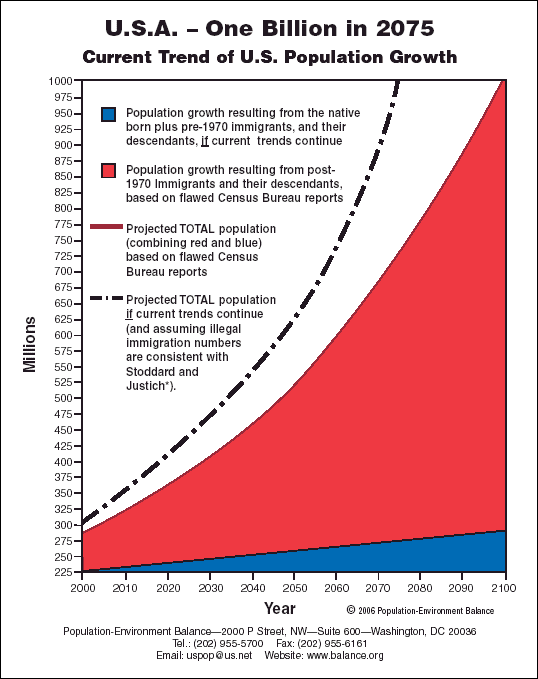Population Projections:
Trends and Explanations September, 2006
October 11, 2006

Population Projections: Trends and Explanations
September, 2006
- The upper dotted line represents the projected
population growth of the United States. Data points through
2005 are based on the USCIS Yearbook of Immigration Studies
for 2000-2005 plus an estimated number of illegal aliens. The
totals are congruent with several estimates* of up to 30 million
illegal aliens in the United States [compared to the Census
Bureau estimate of 12 million]. The trend indicated by joining
the data points 2000 and 2005 indicate that the RATE OF GROWTH
IS INCREASING.
- Extrapolation indicates that the time for
the U.S. population to double is approximately 50 years, which
represents a growth rate of 1.4% annually.
- Not so long ago, the time for the U.S. population
to double was 70 years. The shortening of the doubling time
would indicate that the rate of growth is increasing.
Even on a logarithmic scale, the dotted line would be bending
upward. The slope based on the expectation that the rate of
growth will continue to increase yields a nightmare scenario
of an estimated population of 500 million by 2026, and
I billion by 2075.
- The red section represents the projected
population growth resulting from post-1970 immigrants and their
offspring. This line uses the most recent Center for Immigration
Studies (CIS) estimate, which indicates that legal and illegal
immigration and the offspring of post-1970 immigrants presently
accounts for nearly 90% of U.S. population growth. Legal immigration
accounted for approximately two-thirds of this growth in the
past decade and about half of that growth in recent years. Under
current law and enforcement assumptions, mass immigration
will generate more than 90% of the total U.S. population growth
in the 21st century.
- The blue section represents the projected
population growth resulting from pre-1970 immigrants and the
native born and their offspring. Without post-1970 immigration,
we would be on track to stabilize our population in approximately
the next 30 years. NOTE THAT Census Bureau consistently underestimates
and has had to revise population size upward after each of the
last few censuses. Upward revisions apparently still do not
capture all of the growth, as revealed by discrepancies with
the Census Bureau's own American Community Survey. See comparison
before and after the year 2000 census. The American Community
Survey is a new annual version of the Federal Census Bureau's
long-form questionnaire designed to capture the nation's demographic
profile in a timelier moving picture, rather than a once-a-decade
snapshot.
- The following is the basis for the Year
2000 data points:
Revised Census Bureau corrected by Census Bureau's American
Community Survey: 301 million
Revised Census Bureau figures: 282 million
Unrevised Census Bureau figures [published before 10-year census
results]: 276 million
Population from pre-1970 immigrants and native-born: approximately
225 million
Consequences of Continued U.S.
Population Growth:
- One acre of farmland or wild land
lost for every person added.
- 25.55 barrels of oil consumed annually
for every person added.
- 12,331 kilowatt-hours of electricity
consumed annually for every person added.
- 1,932 cubic meters of water withdrawn
annually from aquifers for every person added.
*Stoddard, David J. “Testimony
Submitted to U.S. Subcommittee on Criminal Justice, Drug Policy
and Human Resources.” Representative Mark Souder, Chairman
February 22, 2002…..Justich, Robert, Ng, Betty. “The
Underground Labor Force Is Rising to the Surface.” New York,
Bear Stearns Asset Management, January 3, 2005…..Corsi, Jerome
and Gilchrist, Jim. “Minutemen: That Battle to Secure America’s
Borders” NewsMax, 2006. Revised Census Bureau corrected by
data from the United States Citizenship and Immigration Services
(USCIS): 301 million
|